Ayodhya
Ayodhya (Hindustani: [əˈjoːdʱːjaː] (![]() listen); IAST: Ayodhyā) is a city and the administrative headquarters of Faizabad district (officially Ayodhya district) and the Faizabad division (officially Ayodhya division) of Uttar Pradesh, India.[4] It shares a municipal corporation with its neighbouring twin town of Faizabad.
listen); IAST: Ayodhyā) is a city and the administrative headquarters of Faizabad district (officially Ayodhya district) and the Faizabad division (officially Ayodhya division) of Uttar Pradesh, India.[4] It shares a municipal corporation with its neighbouring twin town of Faizabad.
Ayodhya
Saketa | |
|---|---|
City | |
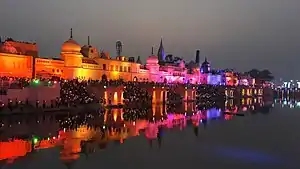 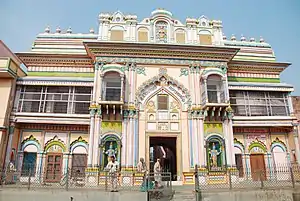 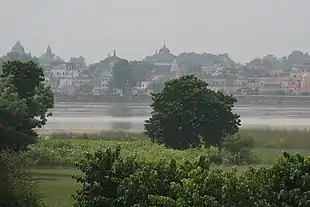 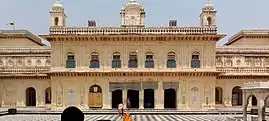 Clockwise from the top: Ram ki Paidi Ghat, Ayodhya Ghaat on the Ghaghara river, Kanak Bhawan Temple, Vijayraghav Mandir in Ayodhya | |
 Ayodhya  Ayodhya | |
| Coordinates: 26.80°N 82.20°E | |
| Country | |
| State | Uttar Pradesh |
| District | Faizabad |
| Government | |
| • Type | Mayor–Council |
| • Body | Ayodhya Municipal Corporation |
| • Mayor | Rishikesh Upadhyay, BJP |
| Area | |
| • Total | 79.8 km2 (30.8 sq mi) |
| Elevation | 93 m (305 ft) |
| Population (2011[1]) | |
| • Total | 55,890 |
| • Density | 700/km2 (1,800/sq mi) |
| Language | |
| • Official | Hindi[2] |
| • Additional official | Urdu[2] |
| • Regional | Awadhi[3] |
| Time zone | UTC+05:30 (IST) |
| PIN | 224001 |
| Telephone code | 05278 |
| Vehicle registration | UP-42 |
| Website | ayodhya.nic.in |
The city is identified by some with the legendary city of Ayodhya, and as such, as being the birthplace of Lord Rama and setting of the epic Ramayana. The accuracy of this identification is central to the Ayodhya dispute: modern scholars variously believe that the present-day Ayodhya is same as the legendary Ayodhya, or that the legendary city is a mythical place that came to be identified with the present-day Ayodhya only during the Gupta period around the 4th–5th century AD.
The present-day city is identified as the location of Saketa, which was an important city of the Kosala mahajanapada in the first millennium BC, and later served as its capital. The early Buddhist and Jain canonical texts mention that the religious leaders Gautama Buddha and Mahavira visited and lived in the city. The Jain texts also describe it as the birthplace of five tirthankaras namely, Rishabhanatha, Ajitanatha, Abhinandananatha, Sumatinath and Anantnath, and associate it with the legendary chakravartins. From the Gupta period onwards, several sources mention Ayodhya and Saketa as the name of the same city.
Owing to the belief as the birthplace of Rama, Ayodhya (Awadh) has been regarded as one of the seven most important pilgrimage sites (Saptapuri) for Hindus. It is believed that the birth spot of Rama was marked by a temple, which is said to have been demolished by the orders of the Mughal emperor Babur and a disputed mosque erected in its place. In 1992, it lead to the demolition of Babri mosque by Hindu mobs with the aim to replace it with a temple of Rama. The Ayodhya dispute concerned activism by Hindu groups to rebuild a grand temple of Rama at the site of Janmabhoomi.[5] The five judges of the Supreme Court bench heard the title dispute cases from August to October 2019. On 9 November 2019, the Supreme Court, headed by Chief Justice Ranjan Gogoi, vacated the previous decision and ruled that the land belonged to the government per tax records. It further ordered the land to be handed over to a trust to build the Hindu temple. It also ordered the government to give an alternative 5 acres (2.0 ha) of land to the Uttar Pradesh Sunni Central Waqf Board to build a mosque to replace the demolished Babri Masjid. The construction of Ram Mandir commenced in August 2020.[6]
Etymology and names
The word "Ayodhya" is a regularly formed derivation of the Sanskrit verb yudh, "to fight, to wage war". Yodhya is the future passive participle, meaning "to be fought"; the initial a is the negative prefix; the whole, therefore, means "not to be fought" or, more idiomatically in English, "invincible".[7] This meaning is attested by the Atharvaveda, which uses it to refer to the unconquerable city of gods.[8] The 9th century Jain poem Adi Purana also states that Ayodhya "does not exist by name alone but by the merit" of being unconquerable by enemies. Satyopakhyana interprets the word slightly differently, stating that it means "that which cannot be conquered by sins" (instead of enemies).[9]
"Saketa" is the older name for the city, attested in Sanskrit, Jain, Sanskrit, Buddhist, Greek and Chinese sources.[10] According to Vaman Shivram Apte, the word "Saketa" is derived from the Sanskrit words Saha (with) and Aketen (houses or buildings). The Adi Purana states that Ayodhya is called Saketa "because of its magnificent buildings which had significant banners as their arms". [11] According to Hans T. Bakker, the word may be derived from the roots sa and ketu ("with banner"); the variant name saketu is attested in the Vishnu Purana.[12]
The older name in English was "Oudh" or "Oude", and the princely state it was the capital of until 1856 is still known as Oudh State.
Ayodhya was stated to be the capital of the ancient Kosala kingdom in the Ramayana. Hence it was also referred to as "Kosala". The Adi Purana states that Ayodhya is famous as su-kośala "because of its prosperity and good skill".[11]
The cities of Ayutthaya (Thailand), and Yogyakarta (Indonesia), are named after Ayodhya.
History

Ancient Hindu Sanskrit-language epics, such as the Ramayana and the Mahabharata mention a legendary city called Ayodhya, which was the capital of the legendary Ikshvaku kings of Kosala, including Rama.[13] Neither these texts, nor the earlier Sanskrit texts such as the Vedas, mention a city called Saketa. Non-religious, non-legendary ancient Sanskrit texts, such as Panini's Ashtadhyayi and Patanjali's commentary on it, do mention Saketa.[13] The later Buddhist text Mahavastu describes Saketa as the seat of the Ikshvaku king Sujata, whose descendants established the Shakya capital Kapilavastu.[14]
The earliest of the Buddhist Pali-language texts and the Jain Prakrit-language texts mention a city called Saketa (Sageya or Saeya in Prakrit) as an important city of the Kosala mahajanapada.[15] Topographical indications in both Buddhist and Jain texts suggest that Saketa is the same as the present-day Ayodhya.[16] For example, according to the Samyutta Nikaya and the Vinaya Pitaka, Saketa was located at a distance of six yojanas from Shravasti. The Vinaya Pitaka mentions that a big river was located between the two cities, and the Sutta Nipata mentions Saketa as the first halting place on the southward road from Shravasti to Pratishthana.[14]
Fourth century onwards, multiple texts, including Kalidasa's Raghuvamsha, mention Ayodhya as another name for Saketa.[17] The later Jain canonical text Jambudvipa-Pannati describes a city called Viniya (or Vinita) as the birthplace of Lord Rishabhanatha, and associates this city with Bharata Chakravartin; the Kalpa-Sutra describes Ikkhagabhumi as the birthplace of Rishabhadev. The index on the Jain text Paumachariya clarifies that Aojjha (Aodhya), Kosala-puri ("Kosala city"), Viniya, and Saeya (Saketa) are synonyms. The post-Canonical Jain texts also mention "Aojjha"; for example, the Avassagacurni describes it as the principal city of Kosala, while the Avassaganijjutti names it as the capital of Sagara Chakravartin.[18] The Avassaganijjutti implies that Viniya ("Vinia"), Kosalapuri ("Kosalapura"), and Ikkhagabhumi were distinct cities, naming them as the capitals of Abhinamdana, Sumai, and Usabha respectively. Abhayadeva's commentary on the Thana Sutta, another post-canonical text, identifies Saketa, Ayodhya, and Vinita as one city.[18]
According to one theory, the legendary Ayodhya city is the same as the historical city of Saketa and the present-day Ayodhya. According to another theory, the legendary Ayodhya is a mythical city,[19] and the name "Ayodhya" came to be used for the Saketa (present-day Ayodhya) only around the fourth century, when a Gupta emperor (probably Skandagupta) moved his capital to Saketa, and renamed it to Ayodhya after the legendary city.[12][20] Alternative, but less likely, theories state that Saketa and Ayodhya were two adjoining cities, or that Ayodhya was a locality within the Saketa city.[21]
As Saketa
Archaeological and literary evidence suggests that the site of present-day Ayodhya had developed into an urban settlement by the 5th or 6th-century BC.[16] The site is identified as the location of the ancient Saketa city, which probably emerged as a marketplace located at the junction of the two important roads, the Shravasti-Pratishthana north–south road, and the Rajagriha-Varanasi-Shravasti-Taxila east–west road.[22] Ancient Buddhist texts, such as Samyutta Nikaya, state that Saketa was located in the Kosala kingdom ruled by Prasenajit (or Pasenadi; c. 6th–5th century BC), whose capital was located at Shravasti.[23] The later Buddhist commentary Dhammapada-atthakatha states that the Saketa town was established by merchant Dhananjaya (the father of Visakha), on the suggestion of king Prasenajit.[14] The Digha Nikaya describes it as one of the six large cities of India.[14] The early Buddhist canonical texts mention Shravasti as the capital of Kosala, but the later texts, such as the Jain texts Nayadhammakahao and Pannavana Suttam, and the Buddhist Jatakas, mention Saketa as the capital of Kosala.[24]
As a busy town frequented by travellers, it appears to have become important for preachers such as Gautama Buddha and Mahavira.[22] The Samyutta Nikaya and Anguttara Nikaya mention that Buddha resided at Saketa at times.[14] The early Jain canonical texts (such as Antagada-dasao, Anuttarovavaiya-dasao, and Vivagasuya) state that Mahavira visited Saketa; Nayadhammakahao states that Parshvanatha also visited Saketa.[18] The Jain texts, both canonical and post-canonical, describe Ayodhya as the location of various shrines, such as those of snake, yaksha Pasamiya, Muni Suvratasvamin, and Surappia.[18]
It is not clear what happened to Saketa after Kosala was conquered by the Magadha emperor Ajatashatru around 5th century BC. There is lack of historical sources about the city's situation for the next few centuries: it is possible that the city remained a commercial centre of secondary importance, but did not grow into a political centre of Magadha, whose capital was located at Pataliputra.[25] Several Buddhist buildings may have been constructed in the town during the rule of the Maurya emperor Ashoka in the 3rd century BC: these buildings were probably located on the present-day man-made mounds in Ayodhya.[26] Excavations at Ayodhya have resulted in the discovery of a large brick wall, identified as a fortification wall by archaeologist B. B. Lal.[16] This wall probably erected in the last quarter of the 3rd-century BC.[27]

After the decline of the Maurya empire, Saketa appears to have come under the rule of Pushyamitra Shunga. The 1st century BC inscription of Dhanadeva suggests that he appointed a governor there.[28] The Yuga Purana mentions Saketa as the residence of a governor, and describes it as being attacked by a combined force of Greeks, Mathuras, and Panchalas.[29] Patanjali's commentary on Panini also refers to the Greek siege of Saketa.[30]
Later, Saketa appears to have become part of a small, independent kingdom.[31] The Yuga Purana states that Saketa was ruled by seven powerful kings after the retreat of the Greeks.[28] The Vayu Purana and the Brahmanda Purana also state that seven powerful kings ruled in the capital of Kosala. The historicity of these kings is attested by the discovery of the coins of the Deva dynasty kings, including Dhanadeva, whose inscription describes him as the king of Kosala (Kosaladhipati).[32] As the capital of Kosala, Saketa probably eclipsed Shravasti in importance during this period. The east–west route connecting Pataliputra to Taxila, which earlier passed through Saketa and Shravasti, appears to have shifted southwards during this period, now passing through Saketa, Ahichhatra and Kanyakubja.[33]
After the Deva kings, Saketa appears to have been ruled by the Datta, Kushan, and Mitra kings, although the chronological order of their rule is uncertain. Bakker theorises that the Dattas succeeded the Deva kings in the mid-1st century AD, and their kingdom was annexed to the Kushan Empire by Kanishka.[34] The Tibetan text Annals of Li Country (c. 11th century) mentions that an alliance of king Vijayakirti of Khotan, king Kanika, the king of Gu-zan, and the king of Li, marched to India and captured the So-ked city. During this invasion, Vijayakirti took several Buddhist relics from Saketa, and placed them in the stupa of Phru-no. If Kanika is identified as Kanishka, and So-ked as Saketa, it appears that the invasion of Kushans and their allies led to the destruction of the Buddhist sites at Saketa.[35]
Nevertheless, Saketa appears to have remained a prosperous town during the Kushan rule.[35] The 2nd century geographer Ptolemy mentions a metropolis "Sageda" or "Sagoda", which has been identified with Saketa.[31] The earliest inscription that mentions Saketa as a place name is dated to the late Kushan period: it was found on the pedestal of a Buddha image in Shravasti, and records the gift of the image by Sihadeva of Saketa.[34] Before or after the Kushans, Saketa appears to have been ruled by a dynasty of kings whose names end in "-mitra", and whose coins have been found at Ayodhya. They may have been members of a local dynasty that was distinct from the Mitra dynasty of Mathura. These kings are attested only by their coinage: Sangha-mitra, Vijaya-mitra, Satya-mitra, Deva-mitra, and Arya-mitra; coins of Kumuda-sena and Aja-varman have also been discovered.[36]
Gupta period
Around the 4th century, the region came under the control of the Guptas, who revived Brahmanism.[37] The Vayu Purana and the Brahmanda Purana attest that the early Gupta kings ruled Saketa.[13] No Gupta-era archaeological layers have been discovered in present-day Ayodhya, although a large number of Gupta coins have been discovered here. It is possible that during the Gupta period, the habitations in the city were located in the areas that have not yet been excavated.[38] The Buddhist sites that had suffered destruction during the Khotanese-Kushan invasion appear to have remained deserted.[39] The 5th-century Chinese traveller Faxian states that the ruins of Buddhist buildings existed at "Sha-chi" during his time.[40] One theory identifies Sha-chi with Saketa, although this identification is not undisputed.[41] If Sha-chi is indeed Saketa, it appears that by the 5th century, the town no longer had a flourshing Buddhist community or any important Buddhist building that was still in use.[31]
An important development during the Gupta time was the recognition of Saketa as the legendary city of Ayodhya, the capital of the Ikshvaku dynasty.[37] The 436 AD Karamdanda (Karmdand) inscription, issued during the reign of Kumaragupta I, names Ayodhya as the capital of the Kosala province, and records commander Prithvisena's offerings to Brahmins from Ayodhya.[42] Later, the capital of the Gupta Empire was moved from Pataliputra to Ayodhya. Paramartha states that king Vikramaditya moved the royal court to Ayodhya; Xuanzang also corroborates this, stating that this king moved the court to the "country of Shravasti", that is, Kosala.[43] A local oral tradition of Ayodhya, first recorded in writing by Robert Montgomery Martin in 1838,[44] mentions that the city was deserted after the death of Rama's descendant Brihadbala. The city remain deserted until King Vikrama of Ujjain came searching for it, and re-established it. He cut down the forests that had covered the ancient ruins, erected the Ramgar fort, and built 360 temples.[44]
Vikramditya was a title of multiple Gupta kings, and the king who moved the capital to Ayodhya is identified as Skandagupta.[43] Bakker theorises that the move to Ayodhya may have been prompted by a flooding of the river Ganges at Pataliputra, the need to check the Huna advance from the west, and Skandagupta's desire to compare himself with Rama (whose Ikshvaku dynasty is associated with the legendary Ayodhya).[44] According to Paramaratha's Life of Vasubandhu, Vikramaditya was a patron of scholars, and awarded 300,000 pieces of gold to Vasubandhu.[45] The text states that Vasubandhu was a native of Saketa ("Sha-ki-ta"), and describes Vikramaditya as the king of Ayodhya ("A-yu-ja").[46] This wealth was used to build three monasteries in the country of A-yu-ja (Ayodhya).[45] Paramartha further states that the later king Baladitya (identified with Narasimhagupta) and his mother also awarded large sums of gold to Vasubandhu, and these funds were used to build another Buddhist temple at Ayodhya.[47] These structures may have been seen by the 7th century Chinese traveller Xuanzang, who describes a stupa and a monastery at Ayodhya ("O-yu-t-o").[48]
Decline as a political centre
Ayodhya probably suffered when the Hunas led by Mihirakula invaded the Gupta empire in the 6th century. After the fall of the Guptas, it may have been ruled by the Maukhari dynasty, whose coins have been found in the nearby areas. It was not devastated, as Xuanzang describes it as a flourshing town and a Buddhist centre.[49] However, it had lost its position as an important political centre to Kanyakubja (Kannauj).[50] At the time of Xuanzang's visit, it was a part of Harsha's empire, and was probably the seat of a vassal or an administrative officer. Xuanzang states that the city measured about 0.6 km (20 li) in circumference. Another 7th-century source, Kāśikāvṛttī, mentions that the town was surrounded by a moat similar to that around Pataliputra.[51]
After the fall of Harsha's empire, Ayodhya appears to have been variously controlled by local kings and the rulers of Kannauj, including Yashovarman and the Gurjara-Pratiharas. The town is not mentioned in any surviving texts or inscriptions composed during 650–1050 AD, although it may be identified with the "city of Harishchandra" mentioned in the 8th-century poem Gaudavaho. Archaeological evidence (including images to Vishnu, Jain tirthankaras, Ganesha, the seven Matrikas, and a Buddhist stupa) suggests that the religious activity in the area continued during this period.[52]
Early medieval period
According to Indologist Hans T. Bakker, the only religious significance of Ayodhya in the first millennium AD was related to the Gopratara tirtha (now called Guptar Ghat), where Rama and his followers are said to have ascended to heaven by entering the waters of Sarayu.[53][54][55]
In the 11th century, the Gahadavala dynasty came to power in the region, and promoted Vaishnavism. They built several Vishnu temples in Ayodhya, five of which survived till the end of Aurangzeb's reign. Hans Bakker concludes that there might have been a temple at the supposed birth spot of Rama built by the Gahadavalas (see Vishnu Hari inscription). In subsequent years, the cult of Rama developed within Vaishnavism, with Rama being regarded as the foremost avatar of Vishnu. Consequently, Ayodhya's importance as a pilgrimage centre grew.[54]
In 1226 AD, Ayodhya became the capital of the province of Awadh (or "Oudh") within the Delhi sultanate. Muslim historians state that the area was little more than wilderness prior to this. Pilgrimage was tolerated, but the tax on pilgrims ensured that the temples did not receive much income.[56]
Mughal and British period
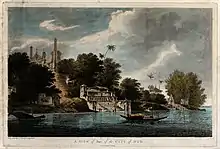
Under Mughal rule, the Babri mosque was constructed in Ayodhya. The city was the capital of the province of Awadh (later Anglicised to "Oudh"), which is also believed to be a variant of the name "Ayodhya."
After the death of Aurangzeb in 1707 AD, the central Muslim rule weakened, and Awadh became virtually independent, with Ayodhya as its capital. However, the rulers became increasingly dependent on the local Hindu nobles, and control over the temples and pilgrimage centres was relaxed.[56] Saadat Ali Khan, Nawab of Awadh, bestowed the riyasat (principality) of Ayodhya on his loyal Brahmin soldier Dwijdeo Mishra of the Kasyapa gotra, for quelling revenue rebels in Mehendauna in Eastern UP.[58]
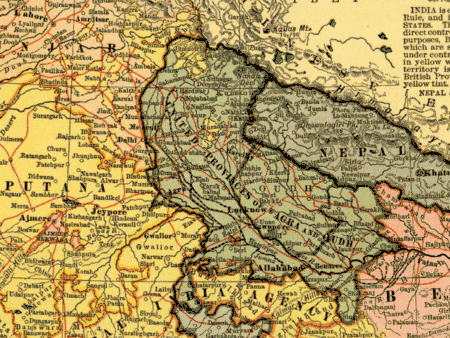
Ayodhya was annexed in 1856 by the British rulers. The rulers of Awadh were Shia, and the Sunni groups had already protested against the permissive attitude of the former government. The British intervened and crushed the Sunni resistance. In 1857, the British annexed Oudh (Awadh) and subsequently reorganised it into the United Provinces of Agra and Oudh.[56]
In the 1850s, a group of Hindus attacked the Babri mosque, on the grounds that it was built over the birthplace of the Hindu deity Rama.[59] To prevent further disputes, the British administrators divided the mosque premises between Hindus and Muslims.[60]
Independent India
| Ayodhya dispute |
|---|
| Organizations |
A movement was launched in 1984 by the Vishwa Hindu Parishad party to reclaim the Babri mosque site for a Rama temple. In 1992, a right wing Hindu nationalist rally turned into a riot, leading to the demolition of the Babri mosque.[61] A makeshift temple at Ram Janmabhoomi for Ram Lalla, infant Rama was constructed.[62] Under the Indian government orders, no one was permitted near the site within 200 yards, and the gate was locked to the outside. Hindu pilgrims, however, began entering through a side door to offer worship.
In 2003, the Archaeological Survey of India (ASI) carried out an excavation at the mosque site to determine if it was built over the ruins of a temple. The excavation uncovered pillar bases indicating a temple had been in existence under the mosque.[63][64] Besides Hindus, the Buddhist and Jain representatives claimed that their temples existed at the excavated site.[65]
On 5 July 2005, five terrorists attacked the site of the makeshift Ramlalla temple in Ayodhya. All five were killed in the ensuing gunfight with security forces, and one civilian died in the bomb blast triggered as they attempted to breach the cordon wall.
On 30 September 2010, the Lucknow bench of the Allahabad High Court ruled that one-third of the disputed land should be given to the Uttar Pradesh Sunni Central Waqf Board, one-third to the Nirmohi Akhara and one-third to the Hindu party for the shrine of "Ram Lalla" (infant Rama). The court further ruled that the area where the idols of Ram are present be given to Hindus in the final decree, while the rest of the land shall be divided equally by metes and bounds among the three parties.[66][67] The judgment, along with evidences provided by the Archaeological Survey of India, upheld that the Babri Masjid was built after demolishing the Hindu temple, which is the birthplace of Rama, and that the mosque was not constructed according to the principles of Islam. The final verdict by the Supreme Court on the case ruled the disputed land in the favour of Hindus for the construction of Ram Mandir and ordered an alternative piece of land be given to the Muslim community for the construction of a mosque.[68][69]
In a judgement pronounced by a 5 judge bench of the Supreme Court of India on 9 November 2019, the land was handed over to the government to form a trust for the construction of a temple. The court instructed the government to also allot a plot of 5 acres (2.0 ha) in Ayodhya to the Uttar Pradesh Sunni Central Waqf Board to construct a mosque/Masjid.[70]
Some South Koreans have identified the "Ayuta" mentioned in their ancient Samgungnyusa legend with Ayodhya. According to this legend, the ancient Korean princess Heo Hwang-ok came from Ayuta. In the 2000s, the local government of Ayodhya and South Korea acknowledged the connection and held a ceremony to raise a statue of the princess.[71][72][73]
Demographics

As of the 2011 India census, Ayodhya had a population of 55,890. Males constituted 56.7% of the population and females 43.3%. Ayodhya had an average literacy rate of 78.1%.[1]
Geography and climate
Ayodhya has a humid subtropical climate, typical of central India. Summers are long, dry and hot, lasting from late March to mid-June, with average daily temperatures near 32 °C (90 °F). They are followed by the monsoon season which lasts till October, with annual precipitation of approximately 1,067 mm (42.0 in) and average temperatures around 28 °C (82 °F). Winter starts in early November and lasts till the end of January, followed by a short spring in February and early March. Average temperatures are mild, near 16 °C (61 °F), but nights can be colder.
Ram temple
For the proposed Ram temple in Ram Janmabhoomi, the Bhoomi Pooja and the Foundation Stone laying were performed by the Prime Minister Narendra Modi on 5 August 2020.
Places of interest
.jpg.webp)
.jpg.webp)
.jpg.webp)
Ayodhya is an important place of pilgrimage for the Hindus. A verse in the Brahmanda Purana names Ayodhya among "the most sacred and foremost cities", the others being Mathura, Haridvara, Kashi, Kanchi and Avantika. This verse is also found in the other Puranas with slight variations.[7] In Garuda Purana, Ayodhya is said to be one of seven holiest places for Hindus in India, with Varanasi being the most sacrosanct.[74]
Hanuman Garhi Fort
Hanuman Garhi, a massive four-sided fort with circular bastions at each corner and a temple of Hanuman inside, is the most popular shrine in Ayodhya. Situated in the center of town, it is approachable by a flight of 76 steps. Its legend is that Hanuman lived here in a cave and guarded the Janambhoomi, or Ramkot. The main temple contains the statue of Maa Anjani with Bal Hanuman seated on her lap. The faithful believe wishes are granted with a visit to the shrine. Kanak Bhawan is a temple said to have been given to Sita and Rama by Rama's stepmother Kaikeyi as a wedding gift, and only contains statues of Sita with her husband.
Ramkot
Ramkot is the main place of worship in Ayodhya, and the site of the ancient citadel of its namesake, standing on elevated ground in the western city. Although visited by pilgrims throughout the year, it attracts devotees from all over the world on "Ram Navami", the day of the birth of Rama. Ram Navami is celebrated with great pomp in the Hindu month of Chaitra, which falls between March and April. Swarg Dwar is believed to be the site of cremation of Rama. Mani Parbat and Sugriv Parbat are ancient earth mounds, the first identified by a stupa built by the emperor Ashoka, and the second is an ancient monastery. Treta ke Thakur is a temple standing at the site of the Ashvamedha Yajnya of Rama. Three centuries prior, the Raja of Kulu built a new temple here, which was improved by Ahilyabai Holkar of Indore in 1784, the same time the adjacent Ghats were built. The initial idols in black sandstone were recovered from Sarayu and placed in the new temple, which was known as Kaleram-ka-Mandir. Chhoti Devkali Mandir is the temple of goddess Ishani, or Durga, Kuldevi of Sita.
Nageshwarnath Temple
The temple of Nageshwarnath was established by Kush, son of Rama. Legend has it that Kush lost his armlet while bathing in the Sarayu, and it was retrieved by a Nag-Kanya who fell in love with him. As she was a devotee of Shiva, Kush built her this temple. It was the only temple to survive when Ayodhya was abandoned until the time of Vikramaditya. While the rest of city was in ruin and covered by dense forest, this temple allowed Vikramaditya to recognise the city. The festival of Shivratri is celebrated here with great splendor.
Other places of interest
 Kanak Bhavan Temple dedicated to Rama and his consort Sita is in the centre of Ayodhya.
Kanak Bhavan Temple dedicated to Rama and his consort Sita is in the centre of Ayodhya. Ayodhya Ghaat on the bank Ghaghara river
Ayodhya Ghaat on the bank Ghaghara river Ghaghra river, locally known as Saryu, at Faizabad.
Ghaghra river, locally known as Saryu, at Faizabad.%252C_India.JPG.webp) Hanuman Garhi temple. A young priest is operating the Darshan system.
Hanuman Garhi temple. A young priest is operating the Darshan system. Vijayraghav Mandir, Ayodhya
Vijayraghav Mandir, Ayodhya%252C_India..JPG.webp) Steps on the bank of the Ghaghara
Steps on the bank of the Ghaghara
Memorial of Heo Hwang-ok
The legendary princess Heo Hwang-ok, who married king Suro of Geumgwan Gaya of Korea, is believed by some to be a native of Ayodhya.[75] In 2001, a Memorial of Heo Hwang-ok was inaugurated by a Korean delegation, which included over a hundred historians and government representatives.[76] In 2016, a Korean delegation proposed to develop the memorial. The proposal was accepted by the Uttar Pradesh chief minister Akhilesh Yadav.[77]
Sister cities
 Gimhae, South Korea
Gimhae, South Korea
- The mayors of Ayodhya and Gimhae signed a sister city bond in March 2001, based on Ayodhya's identification as the birthplace of the legendary queen Heo Hwang-ok.[78]
 Janakpur, Nepal[79]
Janakpur, Nepal[79]
Accessibility
.jpg.webp)
To reach Ayodhya, the nearest airports are Faizabad, 5 km away, Amausi in Lucknow, 134 km away, Allahabad, 166 km away. The city is on the broad gauge Northern Railway line on Mughal Sarai on the Lucknow main route with Ayodhya and Faizabad Railway Stations. Ayodhya is connected by road to several major cities and towns, including Lucknow (134 km), Gorakhpur (132 km), Jhansi (441 km), Allahabad (166 km), Sravasti (109 km), Varanasi (209 km) and Gonda (51 km).
A direct bus service has been started between Ayodhya and Janakpur (birthplace of Sita), in Nepal as a part of Ramayana circuit.[81]
See also
- Saket
- Hanumangarhi
References
- "AYODHYA in Faizabad (Uttar Pradesh)". .citypopulation.de. Retrieved 1 August 2020.
- "52nd Report of the Commissioner for Linguistic Minorities in India" (PDF). nclm.nic.in. Ministry of Minority Affairs. p. 49. Archived from the original (PDF) on 25 May 2017. Retrieved 12 February 2019.
- "Awadhi". Ethnologue. Retrieved 7 May 2019.
- "About District | District Ayodhya – Government of Uttar Pradesh". District Ayodhya – Government of Uttar Pradesh.
- Team, BS Web. "Ayodhya verdict: No place for fear, negativity in 'New India', says PM". www.business-standard.com. Retrieved 9 November 2019.
- "Ayodhya Ram Mandir highlights: Celebration, lamps, fireworks light up the nation as it witnesses a historic day". Deccan Herald. 5 August 2020. Retrieved 15 August 2020.
- Kunal, Ayodhya Revisited 2016, p. 2.
- Bakker, The rise of Ayodhya as a place of pilgrimage 1982, p. 103.
- Kunal, Ayodhya Revisited 2016, p. 4.
- Lutgendorf, Imagining Ayodhya 1997, p. 22.
- Kunal, Ayodhya Revisited 2016, p. 5.
- Bakker, Ayodhya, Part 1 1984, p. 12.
- Bakker, Ayodhya, Part 1 1984, p. 7.
- Bakker, Ayodhya, Part 1 1984, p. 5.
- Bakker, Ayodhya, Part 1 1984, pp. 5–6.
- Bakker, Ayodhya, Part 1 1984, p. 2.
- Bakker, Ayodhya, Part 1 1984, pp. 6–7.
- Bakker, Ayodhya, Part 1 1984, p. 6.
- Arya 1990, p. 44.
- Bhagwan Singh Josh, Bipan Chandra, Harbans Mukhia, K. N. Panikkar, Madhavan K. Palat, Mridula Mukherjee, Muzaffar Alam, R. Champakalakshmi, Rajan Gurukkal, Romila Thapar, Sarvepalli Gopal et al. (1990). "The Political Abuse of History: Babri Masjid-Rama Janmabhumi Dispute". Social Scientist. 18 (1/2): 76–81. doi:10.2307/3517330. JSTOR 3517330.CS1 maint: uses authors parameter (link)
- Bakker, Ayodhya, Part 1 1984, p. 3.
- Bakker, Ayodhya, Part 1 1984, p. 13.
- Bakker, Ayodhya, Part 1 1984, p. 5, 13.
- Bakker, Ayodhya, Part 1 1984, p. 2,5–6.
- Bakker, Ayodhya, Part 1 1984, p. 14.
- Bakker, Ayodhya, Part 1 1984, pp. 14–18.
- Bakker, Ayodhya, Part 1 1984, pp. 19–20.
- Bakker, Ayodhya, Part 1 1984, p. 20.
- Bakker, Ayodhya, Part 1 1984, pp. 18–19.
- Bakker, Ayodhya, Part 1 1984, p. 7,19.
- Bakker, Ayodhya, Part 1 1984, p. 18.
- Bakker, Ayodhya, Part 1 1984, p. 21.
- Bakker, Ayodhya, Part 1 1984, p. 22.
- Bakker, Ayodhya, Part 1 1984, p. 24.
- Bakker, Ayodhya, Part 1 1984, p. 25.
- Bakker, Ayodhya, Part 1 1984, p. 23.
- Bakker, Ayodhya, Part 1 1984, p. 26.
- Bakker, Ayodhya, Part 1 1984, p. 27.
- Bakker, Ayodhya, Part 1 1984, pp. 25–26.
- Bakker, Ayodhya, Part 1 1984, p. 17.
- J. C. Aggarwal; N. K. Chowdhry (1991). Ram Janmabhoomi through the ages: Babri Masjid controversy. S. Chand. p. 7.
- Bakker, Ayodhya, Part 1 1984, p. 28.
- Bakker, Ayodhya, Part 1 1984, p. 29.
- Bakker, Ayodhya, Part 1 1984, p. 30.
- Bakker, Ayodhya, Part 1 1984, p. 31.
- Bakker, Ayodhya, Part 1 1984, p. 8.
- Bakker, Ayodhya, Part 1 1984, p. 32.
- Bakker, Ayodhya, Part 1 1984, p. 18, 31.
- Bakker, Ayodhya, Part 1 1984, pp. 32–33.
- Bakker, Ayodhya, Part 1 1984, pp. 33–34.
- Bakker, Ayodhya, Part 1 1984, p. 33.
- Bakker, Ayodhya, Part 1 1984, p. 34.
- Bakker, The rise of Ayodhya as a place of pilgrimage 1982, p. 105.
- Paramasivan, Vasudha (2009). "Yah Ayodhya Vah Ayodhya: Earthly and Cosmic Journeys in the Anand-lahari". In Heidi R. M. Pauwels (ed.). Patronage and Popularisation, Pilgrimage and Procession. Otto Harrassowitz Verlag. pp. 101–116. ISBN 978-3-447-05723-3.
- Kunal, Ayodhya Revisited 2016, p. 12.
- Bakker, Ayodhya: A Hindu Jerusalem 1991.
- Kunal, Ayodhya Revisited 2016, pp. 439–440: "It is remarkable to note that William Hodges, R.A., who visited Fyzabad and Ayodhya in 1783, made the well known painting of the bank with Svargadvāri mosque."
- Plaint Of Ayodhya, The Financial Express, Sunday, 22 August 2004 at 0000 hrs IST
- Christophe Jaffrelot (1999). The Hindu Nationalist Movement and Indian Politics: 1925 to the 1990s : Strategies of Identity-building, Implantation and Mobilisation (with Special Reference to Central India). Penguin Books India. p. 92. ISBN 978-0-14-024602-5.
- P. Carnegy: A Historical Sketch of Tehsil Fyzabad, Lucknow 1870, cited by Harsh Narain, The Ayodhya Temple Mosque Dispute: Focus on Muslim Sources, 1993, New Delhi, Penman Publications. ISBN 81-85504-16-4 p.8-9, and by Peter Van der Veer Religious Nationalism, p.153
- Amy Chua (2007). Day of Empire: How Hyperpowers Rise to Global Dominance – And Why They Fall. Doubleday. p. 182. ISBN 978-0-385-51284-8.
- "The Hindu: Ram Lalla deity to be taken to Ayodhya". Hinduonnet.com. 19 January 2002. Retrieved 30 September 2010.
- "Proof of temple found at Ayodhya: ASI report". Rediff.com. 25 August 2003. Archived from the original on 26 September 2010. Retrieved 30 September 2010.
- "Evidence of temple found: ASI". 25 August 2003.
- Seema Chishti (14 March 2003). "14 March 2003". BBC News. Retrieved 11 June 2012.
- "Ayodhya verdict: Allahabad High Court says divide land in 3 ways". Ndtv.com. Archived from the original on 2 October 2010. Retrieved 30 September 2010.
- "ram janmbhoomi babri masjid judgement". Rjbm.nic.in. Archived from the original on 2 October 2010. Retrieved 30 September 2010.
- "Ayodhya Verdict LIVE Updates: Entire Disputed 2.77-Acre Land Goes to Hindus for Ram Mandir, Muslims to Get 5 Acres of Alternate Land". News18. 9 November 2019. Retrieved 9 November 2019.
- "Ayodhya Verdict Live Updates: Disputed Land To Be Given For Temple Construction, Muslims To Get 5-Acre Plot In Ayodhya, Says Top Court". NDTV.com. Retrieved 9 November 2019.
- "Ayodhya verdict live updates: Waqf Board couldn't prove exclusive possession of Ayodhya site, says Supreme Court".
- Korean relative of Kings of Ayodhya goes on evidence hunting, Tarannum Manjul, The Indian Express, 21 January 2010, 04:25 hrs
- South Korea's Ayodhya connection, V N Arora, TNN, 12 September 2004, 12.30 am IST
- Festivities organized to honor Indian princess, San Whan Ahn, India Abroad, 12 May 2000
- Stella Kramrisch; Raymond Burnier (1946). The Hindu temple, Volume 1. Motilal Banarsidass. p. 3. ISBN 9788120802230.
- Il-yeon (tr. by Ha Tae-Hung & Grafton K. Mintz) (1972). Samguk Yusa. Seoul: Yonsei University Press. ISBN 89-7141-017-5.
- "Korean memorial to Indian princess". 6 March 2001 – via news.bbc.co.uk.
- UP CM announces grand memorial of Queen Huh Wang-Ock, 1 March 2016, WebIndia123
- V N Arora (12 September 2004). "South Korea's Ayodhya connection". The Times of India.
- "MoU on Twinning arrangements between Kathmandu-Varanasi, Janakpur-Ayodhya and Lumbini-Bodh Gaya as sister cities". pib.gov.in. Retrieved 8 March 2020.
- "PM Narendra Modi signs 10 agreements with Nepal, inaugurates bus service". The Times of India. 26 November 2014.
- "Modi, Oli Jointly Inaugurate Janakpur-Ayodhya Direct Bus Service".
Sources
- Arya, S. N. (1990). "Historicity of Ayodhya". Proceedings of the Indian History Congress. Indian History Congress. 51: 44–48. JSTOR 44148186.
- Bakker, Hans T. (1982). "The rise of Ayodhya as a place of pilgrimage". Indo-Iranian Journal. 24 (2): 103–126. doi:10.1163/000000082790081267.
- Bakker, Hans (1984), Ayodhya, Part 1: The History of Ayodhya from the 7th century BC to the middle of the 18th century, Groningen: Egbert Forsten, ISBN 9069800071
- Bakker, Hans T. (1991). "Ayodhyā: A Hindu Jerusalem: An Investigation of 'Holy War' as a Religious Idea in the Light of Communal Unrest in India". Numen. 38 (1): 80–109. doi:10.2307/3270005. JSTOR 3270005.
- Jain, Meenakshi (2013). Rama and Ayodhya. New Delhi: Aryan Books. ISBN 978-8173054518.
- Hill, John E. (2009). Through the Jade Gate to Rome: A Study of the Silk Routes During the Later Han Dynasty 1st to 2nd Centuries CE. BookSurge. ISBN 978-1-4392-2134-1.
- Kunal, Kishore (2016). Ayodhya Revisited. Ocean. ISBN 978-81-8430-357-5.
- Lutgendorf, Philip (1997). "Imagining Ayodhya: Utopia and its Shadows in a Hindu Landscape". International Journal of Hindu Studies. 1 (1): 19–54. doi:10.1007/s11407-997-0011-z. JSTOR 20106448. S2CID 144225912.
- Pandey, Gyanendra (2006). Routine Violence: Nations, Fragments, Histories. Stanford University Press. p. 97. ISBN 978-0-8047-5264-0.
- Paul, Herman (2015). Key Issues in Historical Theory. Routledge. ISBN 978-1-317-51946-1.
- Narain, Harsh (1993), The Ayodhya Temple Mosque Dispute: Focus on Muslim Sources, Delhi: Penman Publishers
Further reading
| Wikisource has the text of the 1911 Encyclopædia Britannica article Ajodhya. |
| Wikivoyage has a travel guide for Ayodhya. |
- Ayodhya at the Encyclopædia Britannica
- Dhavalikar, M. K. (1988), "Reviewed Work(s): AYODHYĀ Part I (Pts. I-III) by Hans Bakker", Annals of the Bhandarkar Oriental Research Institute, 69 (1/4): 319–320, JSTOR 41693795
- Jain, Meenakshi The Battle for Rama: Case of the Temple at Ayodhya (Aryan Books International, 2017), ISBN 8173055793.
- B. B. Lal (2008). Rāma, His Historicity, Mandir, and Setu: Evidence of Literature, Archaeology, and Other Sciences. Aryan Books. ISBN 978-81-7305-345-0.
- Legge, James (1886): A Record of Buddhistic Kingdoms: Being an account by the Chinese Monk Fa-Hien of his travels in India and Ceylon (A.D. 399–414) in search of the Buddhist Books of Discipline. Oxford, Clarendon Press. Reprint: New York, Paragon Book Reprint Corp. 1965.
- Arun Shourie, Arun Jaitley, Swapan Dasgupta, Rama J Jois: The Ayodhya Reference: Supreme Court Judgement and Commentaries. 1995. New Delhi:Voice of India. ISBN 978-8185990309
- Arun Shourie, Sita Ram Goel, Harsh Narain, Jay Dubashi and Ram Swarup. Hindu Temples – What Happened to Them Vol. I, (A Preliminary Survey) (1990) ISBN 81-85990-49-2
- Thomas, F. W. (1944): "Sandanes, Nahapāna, Caṣṭana and Kaniṣka: Tung-li P'an-ch'i and Chinese Turkestan." New Indian Antiquary VII. 1944, p. 90.
- Watters, Thomas (1904–1905): On Yuan Chwang's travels in India, 629–645 A.D.. London. Royal Asiatic Society. Reprint: Delhi. Mushiram Manoharlal. 1973.
- Ajodhya State The Imperial Gazetteer of India, 1909, v. 5, p. 174.
| Wikiquote has quotations related to: Ayodhya |
.jpg.webp)
